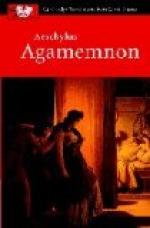The greatest and most human character of the whole play is Clytemnestra. She is conceived on the grand Aeschylean scale, a scale which makes even Lady Macbeth and Beatrice Cenci seem small; she is more the kinswoman of Brynhild. Yet she is full not only of character, but of subtle psychology. She is the first and leading example of that time-honoured ornament of the tragic stage, the sympathetic, or semi-sympathetic, heroine-criminal. Aeschylus employs none of the devices of later playwrights to make her interesting. He admits, of course, no approach to a love-scene; he uses no sophisms; but he does make us see through Clytemnestra’s eyes and feel through her passions. The agony of silent prayer in which, if my conception is right, we first see her, helps to interpret her speeches when they come; but every speech needs close study. She dare not speak sincerely or show her real feelings until Agamemnon is dead; and then she is practically a mad woman.
For I think here that there is a point which has not been observed. It is that Clytemnestra is conceived as being really “possessed” by the Daemon of the House when she commits her crime. Her statements on p. 69 are not empty metaphor. A careful study of the scene after the murder will show that she appears first “possessed” and almost insane with triumph, utterly dominating the Elders and leaving them no power to answer. Then gradually the unnatural force dies out from her. The deed that was first an ecstasy of delight becomes an “affliction” (pp. 72, 76). The strength that defied the world flags and changes into a longing for peace. She has done her work. She has purified the House of its madness; now let her go away and live out her life in quiet. When Aigisthos appears, and the scene suddenly becomes filled with the wrangling of common men, Clytemnestra fades into a long silence, from which she only emerges at the very end of the drama to pray again for Peace, and, strangest of all, to utter the entreaty: “Let us not stain ourselves with blood!” The splash of her husband’s blood was visible on her face at the time. Had she in her trance-like state actually forgotten, or did she, even then, not feel that particular blood to be a stain?
To some readers it will seem a sort of irrelevance, or at least a blurring of the dramatic edge of this tragedy, to observe that the theme on which it is founded was itself the central theme both of Greek Tragedy and of Greek Religion. The fall of Pride, the avenging of wrong by wrong, is no new subject selected by Aeschylus. It forms both the commonest burden of the moralising lyrics in Greek tragedy and even of the tragic myths themselves; and recent writers have shown how the same idea touches the very heart of the traditional Greek religion. “The life of the Year-Daemon, who lies at the root of so many Greek gods and heroes, is normally a story of Pride and Punishment. Each year arrives, waxes great, commits the sin of Hubris and must therefore die. It is the way of all Life. As an early philosopher expresses it, “All things pay retribution for their injustice one to another according to the ordinance of Time."[1]




